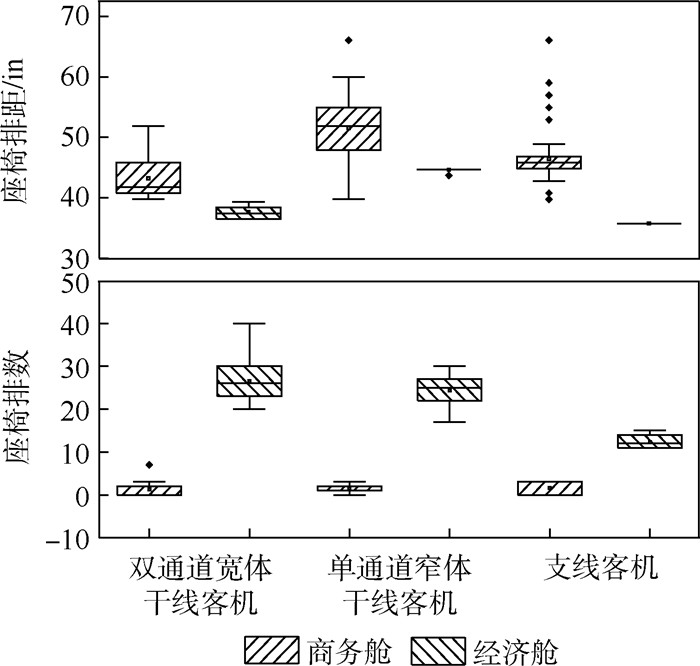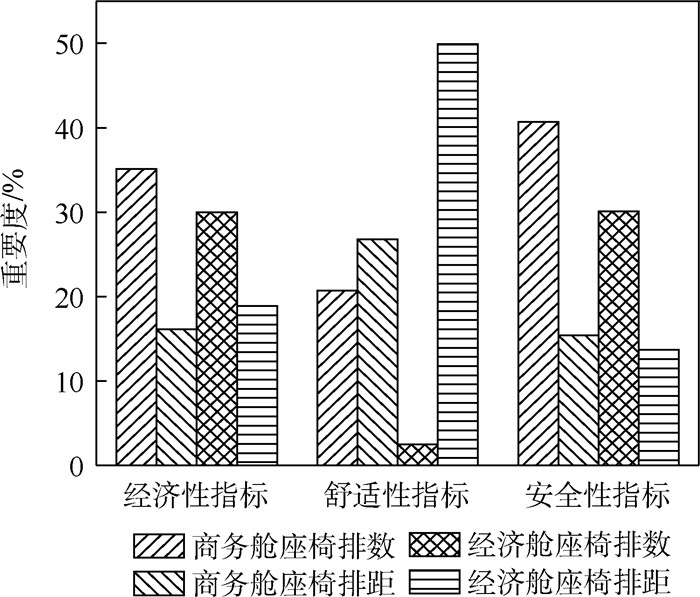-
摘要:
为提升客舱布局设计效率及面向民机客舱快速仿真设计系统提供技术支撑,提出了一种民机客舱布局量化设计模型。该模型面向工效学设计需求,以座椅排距、座椅排数、各级客舱舱段长度等作为设计变量,构造了舒适性、安全性、经济性三类目标函数,实现了客舱边界限制、人机空间耦合关系、适航安全性要求等约束条件的量化描述。分别以双通道宽体干线客机、单通道窄体干线客机和支线客机为应用算例,对所提模型的可用性进行了计算验证。结果表明:所提模型可适用于多种机型的客舱布局设计,能够提供多个满足舒适性、安全性、经济性等多样化工效学设计指标的量化设计方案,并可给出各类指标进一步的优化途径。所提模型在一定程度上实现了民机客舱布局量化设计,为概念设计阶段客舱布局快速设计和多方案比较提供了一种新的方法,同时也可作为航空公司客舱布局选型的定量化辅助决策工具。
Abstract:To improve layout design efficiency and provide technical support for the rapid simulation design system of civil aircraft cabin, a quantitative design model for civil aircraft cabin layout is proposed. The ergonomic demand-oriented model took seat row distance, seat row number and cabin section length as design variables, and constructed three objective functions, which are comfort, economy and safety. The constraints were quantitatively represented in the model, including cabin boundary restriction, man-machine space coupling relationship, and airworthiness safety requirements. Model applicability was verified by taking the dual-aisle wide-body, single-aisle narrow-body, and regional airliner as analytical examples. The results show that the model can be applied to various types of cabin layout design by providing multiple quantitative design schemes meeting ergonomic design requirements. Optimization approaches for various types of indices can also be revealed in the model. It indicates that the quantitative design model could be a new adaptive method for the rapid design and the schemes comparison in the conceptual design stage and a quantitative assistant decision-making tool for the selection of airline passenger cabin layout.
-
表 1 民机客舱布局量化设计模型常量
Table 1. Constants of civil aircraft cabin layout quantitative design model
符号 含义 L 舱段长度 W 舱段宽度 H 舱段高度 L0 厨房盥洗室典型尺寸 Lp 旅客过道宽度 l0 人体身高 lft 人体足长 lba 婴儿摇篮空间长度 φmax 椅背最大后倾角 θ 座椅与纵轴线夹角 lrh 椅背后倾尺寸 lr 座椅椅背长度 lw 座宽 lch 座深 lrm 座椅腿部空间长度 War 座椅扶手宽度 n1 头等舱每排座椅数 n2 商务舱每排座椅数 n3 高级经济舱每排座椅数 n4 经济舱每排座椅数 N 客舱过道数量 u 平均客座率 P 平均票价 Q 应急舱门对数 表 2 三种算例对照机型客舱布置基本信息
Table 2. Basic information of cabin layout for airliner types of three examples
基本信息 双通道宽体干线客机B777-300ER 单通道窄体干线客机B737-800 支线客机MA700 客舱座级 380 180 70 剖面布置 商务舱 2-3-2 2-2 2-1 经济舱 3-4-3 3-3 2-2 应急舱门(对) 2 1 表 3 三种算例的模型常量及其取值
Table 3. Model constants and their values for three examples
客舱长度L/mm 60 000 35 000 21 820 客舱宽度W/mm 5 860 3 750 2 681 客舱高度H/mm 2 591 2 591 1 970 厨房盥洗室典型尺寸L0/mm 1 016 1 016 1 016 人体身高l0/mm 1 678 1 678 1 678 人体足长lft/mm 247 247 247 婴儿摇篮空间长度lba/mm 850 850 850 商务椅背最大后倾尺寸lrh, 2/mm 177.8 177.8 177.8 经济椅背最大后倾尺寸lrh, 4/mm 127 127 127 商务座椅座深lch, 2/mm 508 508 508 商务座椅座宽lw, 2/mm 533.4 510 510 经济座椅座深lch, 4/mm 431.8 431.8 431.8 经济座椅座宽lw, 4/mm 431.8 440 440 商务座椅扶手宽度War, 2/mm 101.6 101.6 101.6 经济座椅扶手宽度War, 4/mm 50.8 50.8 50.8 商务舱每排座椅数n2 7 4 3 经济舱每排座椅数n4 10 6 4 客舱过道数量N 2 1 1 商务舱平均客座率u2/% 100 100 100 经济舱平均客座率u4/% 100 100 100 商务舱平均票价P2/元 2 000 2 000 1 000 经济舱平均票价P4/元 1 000 1 000 500 表 4 三种算例对照机型客舱布局最优备选方案
Table 4. Optimal alternatives of cabin layout for airliner types of three examples
座椅布置 双通道宽体干线客机B777-300ER 单通道窄体干线客机B737-800 支线客机MA700 商务舱座椅排数 0, 2, 3, 1, 7 2, 0, 3, 1 0, 1 商务舱座椅排距/in 41, 40, 50, 42, 47, 43, 46, 52, 51 51, 66, 55, 53, 52, 54, 59, 49, 44, 50, 48, 42, 57, 60, 47, 46, 40 46, 45, 48, 55, 47, 44, 49, 50, 66, 41, 40, 57, 51, 43, 65, 59, 53 经济舱座椅排数 23, 30, 22, 34, 29, 21, 26, 27, 40, 24, 25, 33, 28, 20, 32 25, 20, 27, 24, 26, 30, 21, 23, 22, 29, 28, 17 11, 15, 14, 12, 13 经济舱座椅排距/in 36, 37, 39, 38 45, 44 36 表 5 三种算例对照机型客舱布局设计优先优化途径
Table 5. Prior optimization approach of cabin layout design for airliner types of three examples
设计指标 双通道宽体干线客机B777-300ER 单通道窄体干线客机B737-800 支线客机MA700 经济性 商务舱座椅排数(35.1%) 经济舱座椅排数(67.1%) 经济舱座椅排数(34.4%) 舒适性 经济舱座椅排距(49.9%) 经济舱座椅排距(60.9%) 经济舱座椅排距(49.6%) 安全性 商务舱座椅排数(40.7%) 经济舱座椅排数(80.6%) 经济舱座椅排数(36.7%) -
[1] ABBASOV I B, OREKHOV, V'IACHESLAV V.Computational modeling of passenger amphibian aircraft Be-200 cabin interior[J].Advances in Engineering Software, 2014, 76:154-160. [2] LI D, GUOHUA W, BO C.Operating comfort prediction model of human-machine interface layout for cabin based on GEP[J].Computational Intelligence and Neuroscience, 2015, 2015:1-13. [3] 丁松滨, 章程, 王华伟, 等.基于效用理论的飞机客舱布局选型研究[J].武汉理工大学学报(交通科学与工程版), 2015, 39(3):463-468. http://www.cnki.com.cn/Article/CJFDTotal-JTKJ201503003.htmDING S B, ZHANG C, WANG H W, et al.Research on aircraft cabin layout selection based on utility theory[J].Journal of Wuhan University of Technology (Transportation Science & Engineering), 2015, 39(3):463-468(in Chinese). http://www.cnki.com.cn/Article/CJFDTotal-JTKJ201503003.htm [4] HALL A, MAYER T, WUGGETZER I, et al.Future aircraft cabins and design thinking:Optimisation vs.win-win scenarios[J].Propulsion and Power Research, 2013, 2(2):85-95. [5] SFORZA P M.Commercial airplane design principles[M].Amsterdam:Elsevier, 2014. [6] AHMADPOUR N, LINDGAARD G, ROBERT J M, et al.The thematic structure of passenger comfort experience and its relationship to the context features in the aircraft cabin[J].Ergonomics, 2014, 57(6):801-815. doi: 10.1080/00140139.2014.899632 [7] ABBASOV I B, OREKHOV V V.Computational modeling of the cabin interior of the conceptual model of amphibian aircraft "Lapwing"[J].Advances in Engineering Software, 2017, 114:227-234. [8] VINK P, BAZLEY C, KAMP I, et al.Possibilities to improve the aircraft interior comfort experience[J].Applied Ergonomics, 2012, 43(2):354-359. [9] VINK P, BRAUER K.Aircraft interior comfort and design[M].Boca Raton:CRC Press, 2011. [10] DA SILVA MENEGON L, VINCENZI S L, DE ANDRADE D F, et al.Design and validation of an aircraft seat comfort scale using item response theory[J].Applied Ergonomics, 2017, 62:216-226. [11] 许松林, 周健, 樊彦予.民用支线飞机客舱空间舒适性评价研究[J].航空科学技术, 2014, 25(7):17-22. http://www.cnki.com.cn/Article/CJFDTotal-HKKX201407005.htmXU S L, ZHOU J, FAN Y Y.Research on space comfort evaluation of cabin for regional aircraft[J].Aeronautical Science & Technology, 2014, 25(7):17-22(in Chinese). http://www.cnki.com.cn/Article/CJFDTotal-HKKX201407005.htm [12] 中国民用航空局.中国民用航空规章第25部: 运输类飞机适航标准: CCAR-25-R4[S].北京: 中国民用航空局, 2011: 80-90.CAAC.China civil aviation regulations Part 25: Transport airplane airworthiness criterion: CCAR-25-R4[S].Beijing: CAAC, 2011: 80-90(in Chinese). [13] 祝雯生, 余雄庆.翼身融合布局客机客舱布置快速生成原型系统[J].北京航空航天大学学报, 2020, 46(3):515-523. doi: 10.13700/j.bh.1001-5965.2019.0200ZHU W S, YU X Q.Rapid prototyping system for BWB civil aircraft cabin layout[J].Journal of Beijing University of Aeronautics and Astronautics, 2020, 46(3):515-523(in Chinese). doi: 10.13700/j.bh.1001-5965.2019.0200 [14] 廖慧君, 张曙光.翼身融合布局客机的客舱设计[J].北京航空航天大学学报, 2009, 35(8):986-989. https://bhxb.buaa.edu.cn/CN/Y2009/V35/I8/986LIAO H J, ZHANG S G.Design of cabin layout for blended wing body passenger transports[J].Journal of Beijing University of Aeronautics and Astronautics, 2009, 35(8):986-989(in Chinese). https://bhxb.buaa.edu.cn/CN/Y2009/V35/I8/986 [15] 潘立军, 吴大卫, 谭兆光, 等.基于适航符合性的翼身融合布局客机客舱布置设计[J].航空学报, 2019, 40(9):623044.PAN L J, WU D W, TAN Z G, et al.Cabin layout design for BWB civil aircraft based on airworthiness compliance[J].Acta Aeronautica et Astronautica Sinica, 2019, 40(9):623044(in Chinese). [16] 《飞机设计手册》总编委会.飞机设计手册第7册:民机构型初步设计与推进系统一体化设计[M].北京:航空工业出版社, 2006.Chief Editorial Board.Aircraft design manual book 7:Preliminary design of civil aircraft configuration and integrated design of propulsion system[M].Beijing:Aviation Industry Press, 2006(in Chinese). [17] 樊彦予.航空公司宽体客机客舱布局选型方法浅析[J].科技创新导报, 2016(24):7-13. http://www.cnki.com.cn/Article/CJFDTotal-ZXDB201624002.htmFAN Y Y.Analytical method of product customization for airline wide-body airliner cabin layout[J].Science and Technology Innovation Herald, 2016(24):7-13(in Chinese). http://www.cnki.com.cn/Article/CJFDTotal-ZXDB201624002.htm [18] 刘永明, 韩晓建.飞行器仪器舱自动布局方法研究[J].机械工程与自动化, 2008(3):62-64. http://www.cnki.com.cn/Article/CJFDTotal-SXJX200803024.htmLIU Y M, HAN X J.Research on automatic layout of apparatus cabin of an aircraft[J].Mechanical Engineering & Automation, 2008(3):62-64(in Chinese). http://www.cnki.com.cn/Article/CJFDTotal-SXJX200803024.htm [19] PAI V.On the factors that affect airline flight frequency and aircraft size[J].Journal of Air Transport Management, 2009, 16(4):169-177. [20] 梁晶.客舱布局改造的经济性分析[J].空运商务, 2019(5):47-48.LIANG J.Economic analysis of cabin layout reconstruction[J].Air Transport & Business, 2019(5):47-48(in Chinese). [21] 陆兆伦, 吴通, 王小平.基于效用函数的民机客舱布局概念设计方法[J].装备制造技术, 2018(4):48-52. http://www.cnki.com.cn/Article/CJFDTotal-GXJX201804013.htmLU Z L, WU T, WANG X P.Civil aircraft cabin layout conceptual design based on utility function[J].Equipment Manufacturing Technology, 2018(4):48-52(in Chinese). http://www.cnki.com.cn/Article/CJFDTotal-GXJX201804013.htm [22] CHEN T Y.Aircraft interior for 777X:An adaptive entry interior that optimize the business class passenger and cabin crew inflight experience[J].Estuaries and Coasts, 2015, 38(3):1-15. [23] 中国标准化与信息分类编码所.中国成年人人体尺寸: GB/T 10000-1988[S].北京: 中国标准出版社, 1989.China National Institute of Standardization & Information Classification and Encoding.Human dimensions of Chinese adults: GB/T 10000-1988[S].Beijing: China Standard Press, 1989(in Chinese). [24] YOON J, NGUYEN N, CHOI S M, et al.Multidisciplinary general aviation aircraft design optimizations incorporating airworthiness constraints: AIAA-2010-9304[R].Reston: AIAA, 2010. [25] TAIFA I W R, DESAI D A, BULSARA N M.The development of an ergonomically designed product through an integrated product team approach[J].International Journal of Occupational Safety and Ergonomics, 2018(10):1-19. doi: 10.1080/10803548.2018.1557398 [26] TANABE K.Pareto's 80/20 rule and the Gaussian distribution[J].Physica A:Statistical Mechanics and its Applications, 2018, 510:635-640. -








 下载:
下载:







